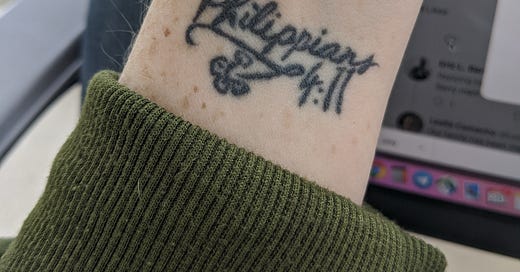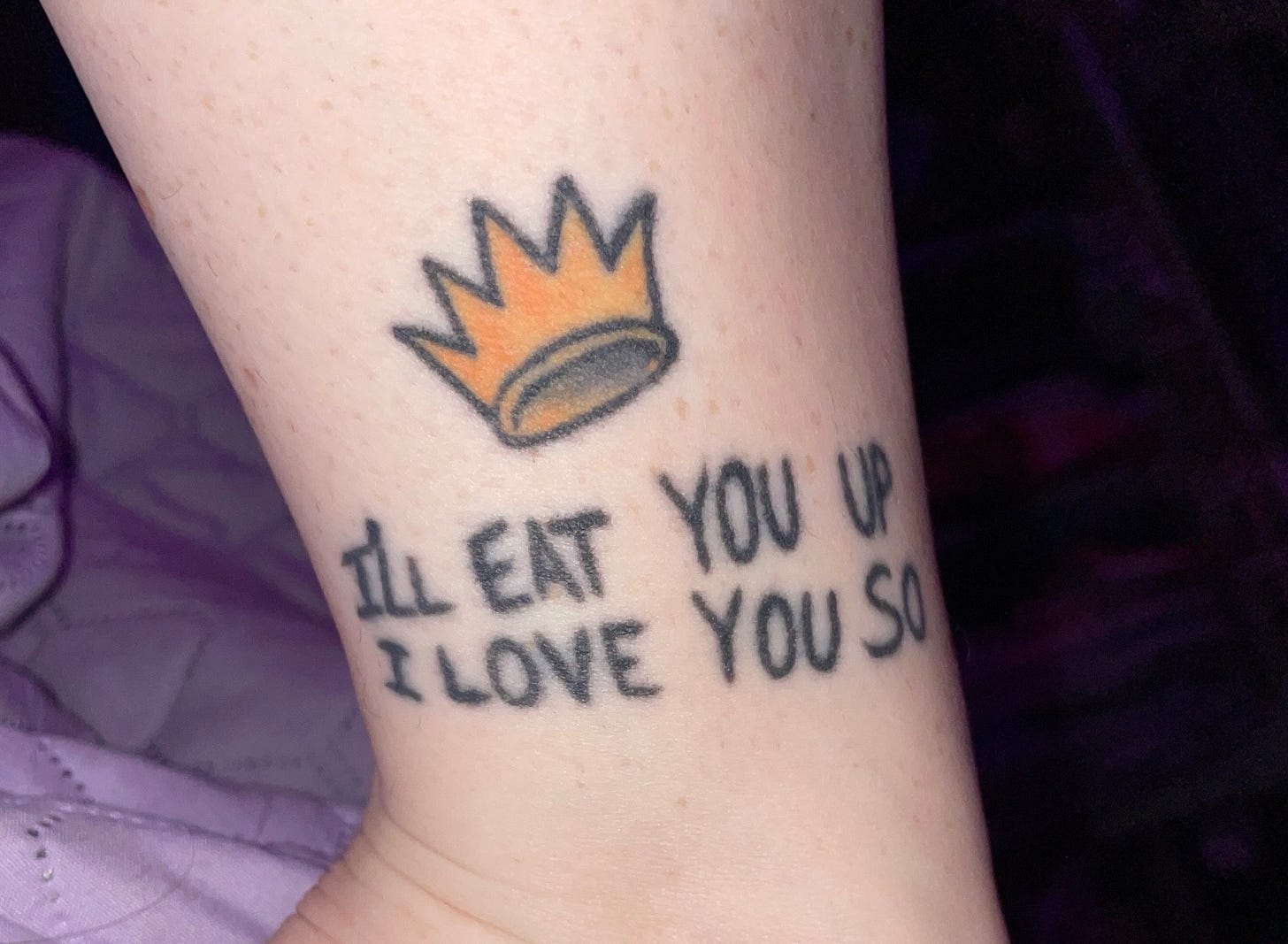The Story I Wrote On My Skin
How I marked survival, reclamation, and becoming—before I even had the words.
This isn’t a story of blame. It’s a story of survival, reclamation, and the quiet ways we find our way back to ourselves—even when no one else notices the journey.
I thought I was just getting tattoos.
But really, I was carving my story into myself before I even had the language to say it out loud.
On my left wrist, facing me—
Philippians 4:11.
It was the first tattoo I was ever "allowed" to get. I had wanted tattoos my entire life, but met my husband at eighteen—and he hated them. Forbade them. So I didn't. Years later, in our 30s, when he decided he wanted one for himself, only then did I finally receive permission to mark my own body.
I chose what I chose as a silent and secret protest against the life I was living—an inked rebellion anyone could see, but almost no one could understand.
A scripture about contentment, placed where I would see and understand it daily.
"...for I have learned, in whatsoever state I am, therewith to be content."
Contentment—not resignation. Not false peace.
Contentment as a quiet, deliberate reclaiming of self and faith.
I told people it was about surviving depression.
And it was.
But it was also about surviving a marriage that told me to shrink.
About surviving a life where my freedom and self-worth had to be negotiated.
Because what I was really saying—what I had lived—was something a lot of people never find the courage to say:
That sometimes, the thing you survive the hardest
is the thing you were meant to call “home.”
And that survival is so quiet, so daily, so expected
that even when you mark it in ink on your body,
you have to translate it into something “acceptable” for everyone else.
“It’s about my depression,”
because that’s easier to hear than
“It’s about my loneliness inside my own marriage.”“It’s about my mental health,”
because that’s less indicting than
“It’s about living in a house built for someone else’s comfort at the expense of my own.”
And still—
I chose contentment.
Not fake peace.
Not resignation.
Not anger.
A steady, intentional return to myself.
Even then, even stitched into a marriage where my autonomy had to be relented to me,
I found a way to say: “I am my own home.”
On my right shoulder blade—
a quill and inkwell, at first, that stretched into a book and a wash of color—an imperfect but stubborn mark of how hard I fought to make beauty out of what I was given.
I brought pictures of feathers, of lightness, of air and grace.
I left with something heavy, leaden, pulled into someone else’s style.
Because I chose the artist my husband trusted.
Because I trusted what had already been chosen for me.
This wasn’t just a tattoo gone wrong.
It was another time I bent myself—again—
to fit into a world that was never built for my signal.
I brought my own vision:
light, airy, perfect in its own voice.
I knew what I wanted.
And still—because it was easier, because it was expected, because it was safe—
I handed it over to someone else's chosen interpreter.
And so I did what I always do:
I tried to fix it.
To balance it.
To adapt.
To make it beautiful anyway.
I added the book in a later session,
then the watercolor.
All with the same artist,
endeavoring for balance, for cohesion,
none of it turning out the way I had envisioned.
But I kept trying.
Because that's who I am.
I'm not a destroyer.
I'm a builder.
Even when I'm handed rubble,
I try to build a cathedral.
Even when it was too heavy.
Even when the colors weren't quite right.
Even when it wasn’t my fault at all.
I was never wrong about what I wanted.
I was just early.
I was too clear in a time and place that didn’t know what to do with that clarity.
It’s not my failure that it didn’t come out the way I dreamed.
It’s proof of how long I’ve been fighting to tune true,
even when everything around me tried to weigh me down.
And still—
even weighted down—
I marked myself as a writer.
As a maker of meaning.
As someone who would, eventually, stop apologizing for her own voice.
Even when it was heavy,
I wore it.
I wore it because it was mine.
On my left ankle—
“I'LL EAT YOU UP / I LOVE YOU SO,”
and Max’s crown from Where the Wild Things Are.
The wild, impossible, glorious love of motherhood—
etched low, by the earth, where every step would carry it forward.
It, too, is larger and heavier than I imagined,
etched by the same hand that drew galaxies for my husband
but couldn’t make a feather weightless for me.
Thicker.
Bolder.
But in this case it’s just like motherhood turned out to be, and I love it as it is.
Not a delicate thing.
Not an airy watercolor.
A love that stamped itself into the ground.
And I carry it with every step.
I wrote the story of my becoming on my skin.
Not perfectly.
Not lightly.
But truly.
And now, when I look at myself—
I see it.
I see her.
I see me.
🌙🖋️







